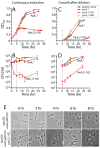Interaction specificity, toxicity and regulation of a paralogous set of ParE/RelE-family toxin-antitoxin systems
- PMID: 20487277
- PMCID: PMC2907451
- DOI: 10.1111/j.1365-2958.2010.07207.x
Interaction specificity, toxicity and regulation of a paralogous set of ParE/RelE-family toxin-antitoxin systems
Abstract
Toxin-antitoxin (TA) gene cassettes are widely distributed across bacteria, archaea and bacteriophage. The chromosome of the alpha-proteobacterium, Caulobacter crescentus, encodes eight ParE/RelE-superfamily toxins that are organized into operons with their cognate antitoxins. A systematic genetic analysis of these parDE and relBE TA operons demonstrates that seven encode functional toxins. The one exception highlights an example of a non-functional toxin pseudogene. Chromosomally encoded ParD and RelB proteins function as antitoxins, inhibiting their adjacently encoded ParE and RelE toxins. However, these antitoxins do not functionally complement each other, even when overexpressed. Transcription of these paralogous TA systems is differentially regulated under distinct environmental conditions. These data support a model in which multiple TA paralogs encoded by a single bacterial chromosome form independent functional units with insulated protein-protein interactions. Further characterization of the parDE(1) system at the single-cell level reveals that ParE(1) toxin functions to inhibit cell division but not cell growth; residues at the C-terminus of ParE(1) are critical for its stability and toxicity. While continuous ParE(1) overexpression results in a substantial loss in cell viability at the population level, a fraction of cells escape toxicity, providing evidence that ParE(1) toxicity is not uniform within clonal cell populations.
Figures






Similar articles
-
A conserved mode of protein recognition and binding in a ParD-ParE toxin-antitoxin complex.Biochemistry. 2010 Mar 16;49(10):2205-15. doi: 10.1021/bi902133s. Biochemistry. 2010. PMID: 20143871 Free PMC article.
-
Mono- and multidomain defense toxins of the RelE/ParE superfamily.mBio. 2025 Apr 9;16(4):e0025825. doi: 10.1128/mbio.00258-25. Epub 2025 Feb 25. mBio. 2025. PMID: 39998207 Free PMC article.
-
New connections in the prokaryotic toxin-antitoxin network: relationship with the eukaryotic nonsense-mediated RNA decay system.Genome Biol. 2003;4(12):R81. doi: 10.1186/gb-2003-4-12-r81. Epub 2003 Nov 26. Genome Biol. 2003. PMID: 14659018 Free PMC article.
-
Functional characterization of toxin-antitoxin system in Mycobacterium tuberculosis.Indian J Tuberc. 2023 Apr;70(2):149-157. doi: 10.1016/j.ijtb.2022.05.010. Epub 2022 May 27. Indian J Tuberc. 2023. PMID: 37100570 Review.
-
Structure and function of bacterial kid-kis and related toxin-antitoxin systems.Protein Pept Lett. 2007;14(2):113-24. doi: 10.2174/092986607779816096. Protein Pept Lett. 2007. PMID: 17305597 Review.
Cited by
-
Intergenerational continuity of cell shape dynamics in Caulobacter crescentus.Sci Rep. 2015 Mar 17;5:9155. doi: 10.1038/srep09155. Sci Rep. 2015. PMID: 25778096 Free PMC article.
-
The ParE2-PaaA2 toxin-antitoxin complex from Escherichia coli O157 forms a heterodocecamer in solution and in the crystal.Acta Crystallogr Sect F Struct Biol Cryst Commun. 2012 Jun 1;68(Pt 6):724-9. doi: 10.1107/S1744309112015230. Epub 2012 May 25. Acta Crystallogr Sect F Struct Biol Cryst Commun. 2012. PMID: 22684081 Free PMC article.
-
Comprehensive Functional Analysis of the 18 Vibrio cholerae N16961 Toxin-Antitoxin Systems Substantiates Their Role in Stabilizing the Superintegron.J Bacteriol. 2015 Jul;197(13):2150-9. doi: 10.1128/JB.00108-15. Epub 2015 Apr 20. J Bacteriol. 2015. PMID: 25897030 Free PMC article.
-
Toxin-antitoxin systems are important for niche-specific colonization and stress resistance of uropathogenic Escherichia coli.PLoS Pathog. 2012;8(10):e1002954. doi: 10.1371/journal.ppat.1002954. Epub 2012 Oct 4. PLoS Pathog. 2012. PMID: 23055930 Free PMC article.
-
WrpA Is an Atypical Flavodoxin Family Protein under Regulatory Control of the Brucella abortus General Stress Response System.J Bacteriol. 2016 Mar 31;198(8):1281-93. doi: 10.1128/JB.00982-15. Print 2016 Apr. J Bacteriol. 2016. PMID: 26858101 Free PMC article.
References
-
- Christensen SK, Gerdes K. RelE toxins from bacteria and Archaea cleave mRNAs on translating ribosomes, which are rescued by tmRNA. Mol Microbiol. 2003;48:1389–1400. - PubMed
-
- Christensen SK, Pedersen K, Hansen FG, Gerdes K. Toxin-antitoxin loci as stress-response-elements: ChpAK/MazF and ChpBK cleave translated RNAs and are counteracted by tmRNA. J Mol Biol. 2003;332:809–819. - PubMed
Publication types
MeSH terms
Substances
Grants and funding
LinkOut - more resources
Full Text Sources
Other Literature Sources
Molecular Biology Databases

